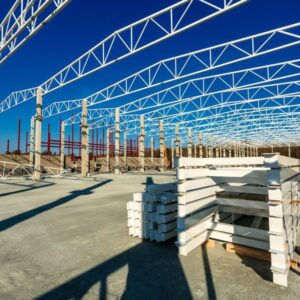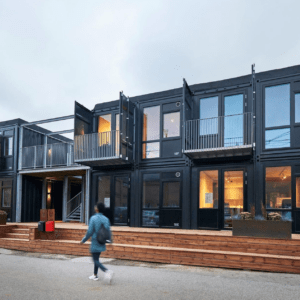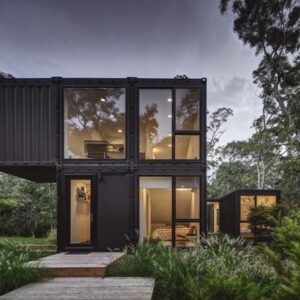Introduction to metal bridges
Metal bridge as a structure type is extremely popular all over the world, and it can have an almost limitless number of variations due to a large number of structural forms possible, as well as different bridge spans, different purposes for a bridge, and so on.
Any metal bridge automatically receives every advantage from a long list of benefits that steel as a material has – including construction speed, strength-to-weight ratio, ductility, mass production and prefabrication capabilities, and so on. These kinds of advantages are what made steel the best material for bridges (especially when it comes to larger bridge construction projects), as well as many other structure types.
Since steel as an alloy can have a multitude of different variations created by adding various elements to it, it is rather difficult to provide specific parameters, but we can safely say that regular, basic steel has about a hundred times more tensile strength than medium concrete, as well as over ten times more compressive strength. There is also the added factor of ductility – steel’s capability to deform before failing since steel as a whole would start to yield quite considerably when above a certain stress level threshold.
Design process of metal bridges
Metal bridge designs have a lot of information to rely upon, with a wealth of guidance available for all kinds of circumstances and use cases. There are three main parts in the design process for metal bridges – concept design, detailed design, and specification. Although it is important to remember that these three parts are less of a step-by-step guide – these three parts are all essential for a proper metal bridge design process to be completed as intended.
Concept design
The first part of the process – the initial concept design – includes the majority of work that goes into designing a metal bridge in the first place. It’s the job of a designer to provide a structural solution in accordance with many different requirements at this step – such as the outline requirements from an alignment engineer, the general topography or other restrictions of the construction site, as well as the general limitations in terms of risks and costs.
This stage may not be too heavy on detailed calculations in terms of the structure’s capabilities, but consulting with main contractors and steelwork contractors is essential to roughly estimate the capabilities of a specific material for a bridge. At this stage it is easy to see how construction industries are positively influenced by government regulations – the UK is a good example of that, creating collaborative arrangements for the majority of bridge construction tasks, thus offering designers quick access to both steelwork and main contractors.
Attempting to minimize the structure’s overall construction cost may be one of the biggest priorities for these kinds of processes, but all of those efforts must not have a negative influence on the health and safety of these structures, bridges included. This step is where the designer would have to consider how the steelwork as a whole would be fabricated and installed, how the bridge itself is going to be erected, and all about how the bridge in question is going to be maintained.
Concept design as a name may not imply a lot of calculations in the first place, but preliminary sizing is essential here, even if done with crude estimates of how the load is going to be distributed for the bridge in question. If the bridge in question is complex enough to facilitate the usage of preliminary design charts and specialized software (composite highway bridges), then calculations are going to be more accurate.
Detailed design
Detailed design as a part of the process may not be as large, but it is no less significant for the overall metal bridge construction process – performing various calculations to ensure that the future structure is both capable of supporting itself and stands up to all the government standards such as Eurocodes. Modeling and analysis are performed for various structural arrangements and under multiple different working conditions. The stability of all the main parts of a bridge is checked as thoroughly as possible. Other operations include checking bracing member sizes, shear connections, stiffener sizes, and more.
Specification
The last, but not the least part of this process is called specification, which is a process of expressing additional requirements for every significant structural element, especially if there are alternatives available for that specific element. The lack of specification is capable of bringing extra risks and higher project costs down the line, while the over-abundance of specifics is bound to drive the overall costs a lot higher than estimates. As such, a balance is required here, which is often taken from industry standards – Specification for Highway Works is a good example of such standards.
Numerous advantages of steel as a construction material for bridges
We have already mentioned some of the more notable advantages of steel as a whole, and how these advantages are beneficial for metal bridges specifically – such as steel’s general strength and durability, as well as its predictability and high level of quality due to its prefabrication/mass production capabilities. However, these are not the only advantages that steel has in this context. Since there are so many advantages in the first place, it would be easier for us to segregate them into multiple categories based on who can take advantage of a specific benefit. There are going to be three different categories: benefits to society, benefits to the environment, and benefits to the economy.
Benefits to society
- Since all of the metal bridge components can be fabricated with high accuracy, steel has the biggest creative freedom in the field, allowing for steel structure variations that would be borderline impossible with other material types.
- The combination of relatively light weight and high strength as a whole makes metal bridges perfect for regions with high seismic activity since lighter superstructures suffer reduced seismic forces as a whole.
- The advantage of high strength is what makes metal bridges the best possible fit for both transit and railroad applications – metal bridges are great at supporting rail live loads, even though these tend to be several times more intensive than highway live loads.
- There are some specific cases where using metal bridges is a matter of accessibility, since no other bridge material is suitable for those conditions.
- Steel components are usually far less susceptible to various environmental hazards when compared with other bridge-making materials.
- Critical utility services can be transmitted in a convenient way using bridges, if necessary.
Benefits to the environment
- Steel production in general is a very environmentally-friendly process since structural steel is 100% recyclable and over 90% of all steel produced in the U.S. is already created using recycled materials in the first place. Steel scrap – the leftovers from the original prefabrication process – can also be used to produce more steel elements, and steel also has a rather low carbon footprint as a whole, minimizing the environmental impact of steel as a construction material.
- Steel’s many different components and bridge variations make it the only material type that is capable of creating some of the biggest bridges in the world, with crossings spanning over 500 feet, and with the help of elements such as trusses, plate girders, suspension bridges, and more.
- General energy usage during construction and even delivery are less when compared with other materials due to the fact that steel is less heavy in comparison.
- Since most of the steel products are produced via some variation of manufacturing, it leaves far less room for excessive uncontrolled waste to be generated during manufacturing as a whole.
Benefits to the economy
- Not only steel is a prime material for larger bridges, but it is also an extremely useful material when a quick bridge replacement is needed for some sort of overpass or a small bridge – providing a cost-effective solution in regard to smaller bridges with basic bridge structures. Steel can also be used to fix existing short-span bridges in a small time frame, making it a modular construction process.
- Steel structures of all types can be reinforced and repaired with relative ease when needed, and this also applies to metal bridges – including both reinforcement for specific parts of a bridge as well as general regular maintenance to improve the bridge’s overall lifespan.
- Metal bridges can not only be repaired but also modified at any point in the future, making them incredibly adaptable and exceptionally durable in terms of a general lifespan.
- The fact that steel structures in general are relatively fast in terms of construction reduces business and/or traffic disruption times when steel structures are installed.
Durability in metal bridges
The topic of the overall durability that metal bridges can have is a rather important one, which is why it is going to be explained here in a bit more detail. Metal bridges as a structure type have a proven lifespan of over a century, with one of the most notable examples of that being the Forth Rail Bridge from Scotland. This bridge was built in 1890 and it is still in working condition to this day.
There are multiple reasons why steel is this useful when it comes to long-term structures. For example, this particular material has a very predictable fatigue life, with most of its elements in a structure being accessible and visible at all times. This makes it fairly easy to notice even the smallest deterioration signs.
Corrosion, as one of the biggest problems of steel as a whole, is mostly a surface effect that takes a long time to compromise a bridge’s structural integrity, and it is also possible to repair or replace corrupted parts in most cases. Additionally, various advancements in the technology of coating led to corrosion being even less of an issue if the correct coating is chosen beforehand, offering as many as 30 years of upkeep with no maintenance.
Metal bridges can also adapt to various road configuration changes easier than other material types. There is a very specific example of that – the Tamar suspension bridge located in Plymouth. It only supported 3 lanes in its original form, but replacing the concrete deck with a steel one (with the addition of steel cantilever sections) made it possible to widen the bridge up to 5 lanes with very little difference in weight.
As such, here are some of the most important factors that need to be taken into consideration for a metal bridge to last as long as possible:
- Efficient surface preparation
- Correct specifications
- Understanding of how corrosion works
- Quality control and regular inspection
- Clever design
- High-quality coatings
- Careful coating application
Types of metal bridges
There are many different types of metal bridges that can be created due to the overall versatility and strength of steel as a construction material. Presented below are some of the more common metal bridge types.
Arch bridge
A metal bridge type that has become more popular in recent years, an arch bridge is a bridge type that exerts the horizontal thrust on the foundation of a bridge after being sprung upwards from that same foundation, with steel arches acting in compression most of the time. The deck of this bridge type can be either suspended from the arch, supported by struts, or sit directly on the arch.
If the bridge in question is above some sort of a waterway, there is also a different sub-type of an arch bridge called bowstring arch (or tied-arch), which hangs the deck from the arch above it. It is a great option for bridges that have soft ground underneath them, although waterways remain the biggest use case for this bridge variation.
Box girder bridge
Box girders can be both their separate type of bridge or a part of another type of metal bridge that is somewhat composite. At its core, a “box” part of a box girder is created by the connection of two steel webs between each other with flanges specifically at the top and the bottom. This is where the box comes from – a closed cell with decent torsional stiffness and other capabilities.
Longer bridge variations can use two boxes instead of one, connecting the two with cross beams. If the length of a bridge is even longer, then it becomes more viable to create custom shapes for box girders since bridges themselves are either suspension or cable-stayed at this point, meaning that aerodynamic performance is at its most important.
Suspension bridge
Speaking of suspension bridges, it is one of those cases when the structure itself looks incredibly complex, but in reality, it has a fairly simple process behind it. A shallow curve is formed by hanging two steel cables between two supports, with additional cables connecting the ground with said supports. Hanging cables are used to suspend the deck in the air, with all of the cables absorbing tension forces.
The existence of a deck spreads out the overall load and stiffens the structure itself, preventing the entire bridge from twisting or bending if performed correctly. It is a great option for long-span bridges due to the relatively low costs of the entire structure.
Truss bridge
The concept of a truss framework is relatively well-known in the industry – a large net of steel triangles that are often used to hold roofs or simpler bridges. It is also a bridge type on its own, due to its ability to work in both compression and tension, and it is often used in many other types of bridges, such as arch bridges, suspension bridges, etc.
Beam bridge
The concept of a beam bridge is also relatively simple – reinforced concrete deck slabs are held up by I-beams made of steel. It has two distinct variations to itself – ladder decks, which only use two steel beams for the entire bridge but use additional bracing between the bridge’s supports, and multi-girders, which use a multitude of steel beams to support the entire deck.
Cable-stayed bridge
The cable-stayed bridge is one of many structures that would be pretty much impossible without the existence of steel as a whole. Tension wires are spread out at specific intervals along the length of the main girders, supporting them by connecting girders to either a pylon or a steel mast. The tower itself can be a regular column, an H-frame, or an A-frame, all acting in compression. Since steel is so strong as a material, it is even possible to create two rows of supports for one bridge, if necessary – although using one line of supports is still a viable option.
Different components and elements that can be a part of a metal bridge
Since there are so many variations of metal bridges and a countless number of circumstances every different bridge would have to be built in, it is only natural for metal bridges to consist of a multitude of different elements that are connected to each other – just like almost any other structure made of steel.
It is worth noting that some of these metal bridge elements and components are used in almost any bridge type, while others would be extremely case-specific and only usable in a short list of situations.
Foundation
An integral part of basically any regular metal bridge, the foundation is pretty much every part of a bridge that is placed below the ground level. There can be multiple different foundation types depending on circumstances and bridge type – with pile foundation, well foundation, and open foundation being some of the biggest examples.
Pile cap
Some of the foundation types would have to have an additional element added to them called a cap (well and pile foundations are good examples of these cases). The main purpose of a cap is to serve as a connection between the bridge components that are placed above the ground level, transmitting weight loads from the highest elements of a metal bridge to the lowest – such as the aforementioned foundation.
Deck
A deck is one of the main parts of a bridge – its surface. A deck can not only be made using steel, but there can also be other materials in its place, such as wood, concrete, or open grating. A deck is where all of the specialized covering goes, be it asphalt concrete for cars/pedestrians, railroad bed for trains, and more.
A deck can act as one of the primary structural elements in some specific cases – mostly with cable-stayed and tied-arch bridges – supporting the entire bridge span by carrying compressive or tension forces. A concrete deck can also be supported by other elements instead – these supporting elements can be girders, I-beams, etc.
Beam
The biggest use case for beams is to act as supporting structures, but they can only be used for smaller bridges with relatively short bridge lengths since beams do not have built-in supports for themselves. The main deciding factor for any beam bridge is what is the distance between support elements since this distance has a direct correlation to how strong this bridge is going to be.
As such, some of the more common examples of beam bridges usually go for about 80 meters or less. However, this does not mean that it is impossible to build longer bridges with this structure – it only means that you would have to use multiple beam bridge segments that are connected to each other (the term “continuous span” is used for these kinds of bridges).
Girder
A girder is a variation of a regular steel beam that shares a lot of its characteristics – but there are also differences. For example, a girder can be made of both steel and concrete (and the variation of a girder that uses a steel beam enclosed into a concrete box is incredibly popular in rural areas that have a lot of corrosion-friendly environments). However, a lot of the similarities are still there, with the girder’s strength being mainly decided using parameters such as the girder’s height, material type, girder weight, girder shape, and so on.
Bearing
A specific element that provides a resting surface between the bridge deck and that bridge’s piers is called a bearing. The main purpose of a bearing is to reduce the potential stress by allowing for controlled movement of the entire bridge’s structure. There can be many sources of stress that a bearing can help with, be it internal stress (fatigue, contraction, shrinkage, etc.) or external (seismic activity, ground settlement, thermal expansion, and so on).
Pier
A pier is an element that has only one purpose – to transfer either horizontal or vertical loads from the superstructure to the foundation and below. Piers are also used to accommodate for several other factors, be it water, wind, or vehicle collision. Piers can be made in several different shapes, ranging from relatively simple to rather complex and composite.
Substructure and superstructure
A substructure is a part of a metal bridge that consists of everything below the level of bearings, including bedblock, piers, footings, shafts, coping, and many other elements that are located in the lower part of a bridge.
Alternatively, a superstructure is the upper part of a bridge – every part of the structure that receives the direct live load of the bridge itself. It is the main supporting structure of the bridge as a whole – and it uses its own supporting elements to transfer the load to lower metal bridge elements.
Hanger/pin connection
It is a relatively simple combination of a hanger and two pins, and its main purpose is to be used in specific configurations of a bridge – mainly with a suspended span or articulated span. The placement of these elements is up for debate for each specific use case.
Welded connection
A welded connection is a rigid one-piece construction that uses two different parts fused in one joined part. Welded connections exist to connect elements or to make structural connections as a whole. There is also a difference between smaller temporary welds and proper welding processes since temporary welds (tack welds) only exist for a specific time frame and do not have the strength of a fully-welded connection.
Splice connection
As with the aforementioned beam bridge use case or with many other use cases, there might come a need to create multiple bridge spans that are connected to each other. These kinds of connections are called “splice connection”, and they can be performed both in the field during the construction process and in the fabrication shop beforehand. Splice connections can be created with welds, rivets, or bolts, with bolted splice connections being the more common ones.
Anchor
In a traditional sense, an anchor is what holds a floating object of sorts in a single place, be it on the ground or connected to another physical object. In the context of metal bridges, an anchor is a series of cantilevers that are used to keep specific parts of the bridge in place.
Suspension cable
A suspension cable is what connects an anchor to the bridge part, transmitting part of the overall load to tension via these cables. There can be multiple different types of suspension cables, such as main cables, vertical suspender cables, and so on. Suspension cables can also support either one or two bridge spans with the help of support pillars (for highway-related bridges or bridges that go over canyons).
Examples of metal bridges
Of course, this is quite a lot of information to take in at once, especially since the topic itself is not that easy to begin with. To make it easier to understand some of the more basic metal bridge components, we have collected a number of examples that showcase different bridge use cases and different steel structures that are used to create a metal bridge.
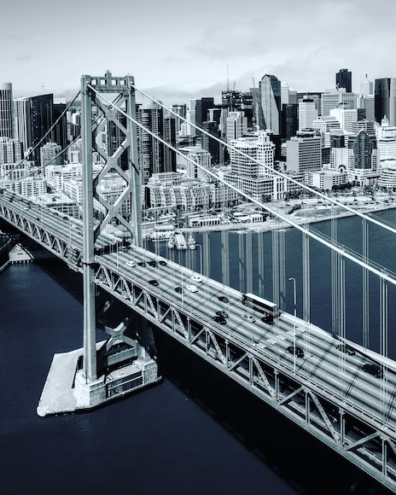
Here you can see a prime example of why metal bridges are so valued and popular all over the world – a structure like this would be a lot harder to recreate without all of the steel’s advantages as a material. You can see here that the bridge’s superstructure relies a lot on a multitude of suspension cables, and the substructure is full of welded connections, splice connections, bearings, and so on. We can’t also forget about a massive deck made specifically for automotive vehicles and their respective weight in mind.
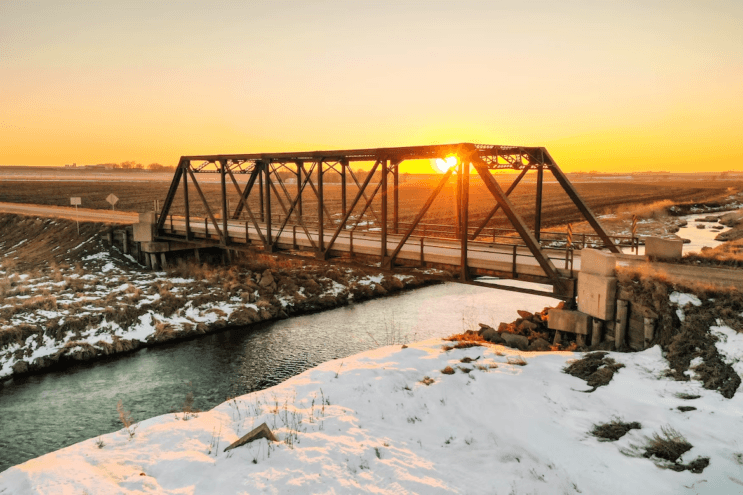
Not all metal bridges have to be these complex structures with hundreds of meters in span, there are many use cases for smaller bridges, too – and this is one such example. Its superstructure is far less complex than the example above, with this one mainly relying on interconnected steel beams and other elements to create a rigid steel frame of sorts. The substructure mainly consists of a set of beams with no supporting structures in the middle of the bridge itself.

Additionally, not all metal bridges are built for automotive or pedestrian-related purposes, it is also fairly common to create bridges for the sole purpose of creating a pathway for trains over some sort of obstacle – in this example that obstacle is a body of water. This bridge uses a relatively common structure in general, with one large nuance – the entire deck of the bridge is replaced with a railroad bed, making this bridge suitable for trains only. In this image, we can also see a superstructure similar to the previous example – a steel frame that is used to distribute the transport’s load and transfer it to the lower parts of the bridge.

Metal bridges can be quite versatile when they need to be, offering passage to multiple types of people or transport at the same time. In this particular example, we can see that a regular automotive-related bridge with asphalt as its main material has also created a separate pathway for pedestrians to use – and this part’s desk is made of wood, not steel or concrete. This kind of versatility is great for bridges in all kinds of active and popular locations, combining multiple types of pathways in one location.

Our last example is another showcase of steel as a material for bridge building – a massive structure several hundred meters in a span that offers several lanes of vehicle crossing space along with a walkway for pedestrians. You can see that this structure relies a lot on bearings and suspension cables to distribute its load, and there are also anchors, piers, welded connections, and other metal bridge elements that help this bridge perform at its best at all times.
Conclusion
There are many reasons why metal bridges are so commonly used all over the planet, and the main reason for that is a large list of advantages that steel itself has as a material. Steel can be customized, it can withstand massive loads, it can be used to create extremely long bridges, the overall speed of construction is higher than the competition, and so on. In this article, we have managed to showcase steel’s advantages as a whole, list a lot of different metal bridge elements, and even showcase some examples of metal bridges with different designs and composition ideas.
Levstal Group is a highly efficient metal fabrication company that offers a variety of metal-related services to its clients, including fabricating various steel elements in a multitude of shapes and sizes, as well as several different metal fabrication services – cutting, welding, and machining, for example. Levstal is well-known for providing quality services and products that meet all of the necessary safety requirements and regulations.
On the topic of steel bridges specifically, one of the more recent projects that Levstal made is a pedestrian bridge in Stockholm – creating and installing all of the necessary steel parts that meet the client’s specifications. Levstal has been on the market for over thirty years now, providing top-quality service and collecting a large number of satisfied clients for its portfolio.
- Introduction to metal bridges
- Design process of metal bridges
- Concept design
- Detailed design
- Specification
- Numerous advantages of steel as a construction material for bridges
- Benefits to society
- Benefits to the environment
- Benefits to the economy
- Durability in metal bridges
- Types of metal bridges
- Arch bridge
- Box girder bridge
- Suspension bridge
- Truss bridge
- Beam bridge
- Cable-stayed bridge
- Different components and elements that can be a part of a metal bridge
- Foundation
- Pile cap
- Deck
- Beam
- Girder
- Bearing
- Pier
- Substructure and superstructure
- Hanger/pin connection
- Welded connection
- Splice connection
- Anchor
- Suspension cable
- Examples of metal bridges
- Conclusion





